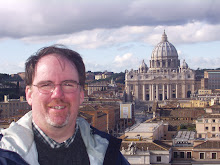 The first reading for today's Mass is taken from the Acts of the Apostles (4:1-12) and is one which visitors to the O'Connor Center may find familiar. The artistic highlight of the chapel is floor-to-ceiling mosaic depicting the scene from this Scripture.
The first reading for today's Mass is taken from the Acts of the Apostles (4:1-12) and is one which visitors to the O'Connor Center may find familiar. The artistic highlight of the chapel is floor-to-ceiling mosaic depicting the scene from this Scripture.The 30-foot mosaic is original to the chapel, which was dedicated in 1964. It was designed by a German-born artisan in Milwaukee, Felix G. Senger, and assembled in Berlin. Many people involved in the project remember its installation because it first was laid out in the lobby of the seminary and then assembled--piece by piece--on the chapel wall. The mosaic is composed of glass and marble and is made up of over 360,000 pieces.
The Risen Christ stands radiantly as the focal point of the artwork, showing the glorified wounds on his hands in the familiar orans position.
On the lower third of the mosaic is depicted the climax of the account of Peter and John healing a disabled man outside of the temple (previous portions of this were read on Wednesday and Thursday of this week).
Peter and John were going to the temple for prayer, and this man, disabled from birth, was begging for alms at the "Beautiful Gate" of the temple. Upon hearing him, Peter looked him in the eye and said, "I have neither silver nor gold, but what I do have I give you: in the name of Jesus Christ the Nazorean, (rise and) walk" (Acts 3:6). The man did just that, amazing all who were familiar with him.
Peter and John began preaching to all who had witnessed the miracle, but they were arrested on orders from the temple leaders. Jailed over night, they were questioned the following day. When asked on what authority they had healed this man, Peter was filled with the Holy Spirit and his testimony is inscribed in the mosaic:
In the name of Jesus Christ of Nazareth
whom you crucified,
whom God has raised from the dead,
even in this name
does he stand before you sound. (Acts 4:10)
This inscription highlighted the original name of the building, "Holy Name Seminary." The building was built by the first Bishop of Madison, Bishop William P. O'Connor (1886-1973). His episcopal motto, In Nomine Jesu (In the Name of Jesus), gave rise to both the building's name and the mosaic's image. Bishop O'Connor was a "Council Father," having attended the first two sessions of the Second Vatican Council.
The Seminary was formally closed in 1995 and was renovated in 1998. The building was renamed to honor that first bishop and is now the Bishop O'Connor Catholic Pastoral Center. The Chapel was renamed the Bishop O'Donnell Holy Name Memorial Chapel. The chapel was beautifully renovated at that time and magnificent stained glass windows were installed depicting Christ, the saints (including one of the first depictions of Blessed Teresa of Calcutta--Mother Teresa--in the world), and the works of mercy that we are called to perform as the Body of Christ.
On a side note, I have always felt that mosaics shed some light on the nature of the Church. Hundreds of thousands of pieces of glass and marble are used in this particularly mosaic, and each one is important. Some are made in brilliant colors--gold, maroon and red. Some are less brilliant and in muted tones. Some make up important figures--the face of Christ or the hand of Peter--while others are relegated to seemingly less important areas--an apostolic toe or perhaps a simple piece of the background far from where the eye is drawn.
Yet each uniquely shaped and colored piece is important and adds to the beauty of the whole. Each has a place and a job. If even one piece of glass was removed from the least significant portion of this mosaic, we would notice. The beauty of the whole would be diminished. If one piece was too brilliant it, too, would diminish the whole, detracting from the overall beauty and calling attention to itself.
Like a mosaic, we can't all be the most beautiful, eloquent, or influential in the Church. But each one is needed or the entire Body is diminished.

Thank you for your edifying remembrance on the Holy Name mosaic. I am particularly struck by your reflection on mosaics in general. I recall my days as a student at Holy Name Seminary in the late ’70. At that time the tabernacle was centered against the mosaic wall behind the altar. You can see its outline in the mosaic between the apostles directly below the text and the face of Christ. Building on your insight, each of us – bright and bold or muted and mundane – are all gathered and sent from the Table nourished by the One in whose name we gather. In Easter, let us pray that we all may find our place and portion in the mosaic.
ReplyDelete